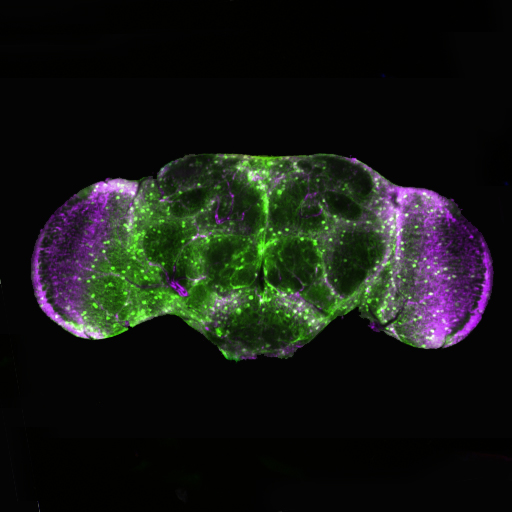Toxic proteins cause neurodegeneration in motor neuron disease and dementia

In the fruit fly Drosophila melanogaster, scientists can study very well how nerve cells are damaged: brain of an adult fly (glial cells are stained green, cell nuclei purple). Image courtesy of Dr. Teresa Niccoli, University College London, UK
Scientists at the Max Planck Institute for Biology of Ageing in Cologne and University College London have now unearthed the way in which a specific genetic mutation leads to neuronal damage in two serious afflictions, that might even occur at once in a single person: Until now, it has been unknown what causes amyotrophic lateral sclerosis and frontotemporal dementia.
Amyotrophic lateral sclerosis is a devastating type of motor neuron disease that causes rapid weakening of muscles and death. Frontotemporal dementia is the second most common cause of dementia in people under 65. It causes distressing symptoms, including changes in personality and behaviour and problems with language and thinking.
The DNA of affected patients contains a mutation: There are thousands of repeats of a specific short segment of genetic material, whereas in unaffected persons, there are only up to thirty copies of this segment. This specific genetic alteration is the cause of illness in around eight percent of patients with this type of motor neuron disease or dementia. Eight percent is a relatively high proportion. For instance, less than one percent of the causes in Alzheimer’s disease are genetic.
Researchers at the Max Planck Institute for Biology of Ageing, the Institute of Neurology and Institute for Healthy Ageing at University College London have now discovered that the repeats in the mutant gene cause neurodegeneration by making toxic proteins.
Fruitflies can undergo neurodegeneration in a similar way to humans
Previously it was thought that the problem could be a consequence of disruption of the gene by the inserted repeats. Another theory was that the repeats produce a different type of toxic RNA molecule. It now turns out that the repeats in the mutant gene can produce a variety of proteins and that two of these are extremely toxic to nerve cells. Both are highly enriched in arginine, an amino acid.
To pinpoint the role of the toxic proteins, the researchers produced artificial repeat segments that could produce potentially toxic RNA and protein or only toxic RNA or only protein. They then introduced them into the nerve cells of fruit flies, which can undergo neurodegeneration in a similar way to humans. Repeat segments that made both RNA and protein caused striking neurodegeneration and reduced the lifespan of the flies, showing that they are a good organism in which to study these diseases. Interestingly, the protein-only repeat segments caused just as bad a neurodegeneration. In contrast, the RNA-only segments were harmless, pinpointing the role of toxic proteins in these diseases. The proteins that contained arginine were the most toxic.
These findings have uncovered a new toxic role for arginine-containing proteins in motor neuron disease and dementia, which helps in the development of drugs to fight these serious afflictions.
Original publication:
C9orf72 repeat expansions cause neurodegeneration in Drosophila through arginine-rich proteins.
Sarah Mizielinska, Sebastian Grönke, Teresa Niccoli, Charlotte E. Ridler, Emma L. Clayton, Anny Devoy, Thomas Moens, Frances E. Norona, Ione O.C. Woollacott, Julian Pietrzyk, Karen Cleverley, Andrew J. Nicoll, Stuart Pickering-Brown, Jacqueline Dols, Melissa Cabecinha, Oliver Hendrich, Pietro Fratta, Elizabeth M.C. Fisher, Linda Partridge, and Adrian M. Isaacs.
Science Express, August 7, 2014.
Media Contact
All latest news from the category: Life Sciences and Chemistry
Articles and reports from the Life Sciences and chemistry area deal with applied and basic research into modern biology, chemistry and human medicine.
Valuable information can be found on a range of life sciences fields including bacteriology, biochemistry, bionics, bioinformatics, biophysics, biotechnology, genetics, geobotany, human biology, marine biology, microbiology, molecular biology, cellular biology, zoology, bioinorganic chemistry, microchemistry and environmental chemistry.
Newest articles

“Nanostitches” enable lighter and tougher composite materials
In research that may lead to next-generation airplanes and spacecraft, MIT engineers used carbon nanotubes to prevent cracking in multilayered composites. To save on fuel and reduce aircraft emissions, engineers…

Trash to treasure
Researchers turn metal waste into catalyst for hydrogen. Scientists have found a way to transform metal waste into a highly efficient catalyst to make hydrogen from water, a discovery that…

Real-time detection of infectious disease viruses
… by searching for molecular fingerprinting. A research team consisting of Professor Kyoung-Duck Park and Taeyoung Moon and Huitae Joo, PhD candidates, from the Department of Physics at Pohang University…





















